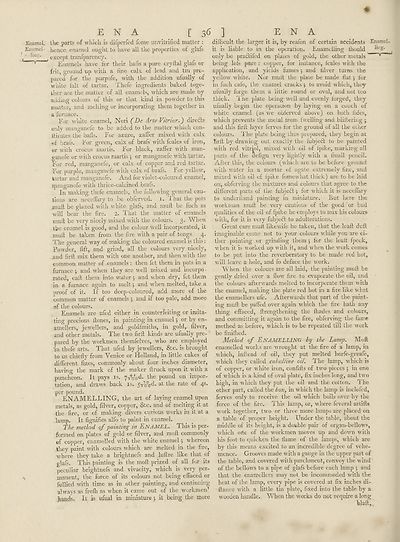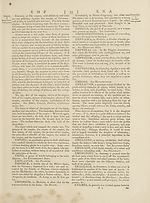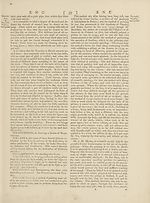Encyclopaedia Britannica, or, a Dictionary of arts, sciences, and miscellaneous literature : enlarged and improved. Illustrated with nearly six hundred engravings > Volume 8, ELE-FOR
(48) Page 36
Download files
Complete book:
Individual page:
Thumbnail gallery: Grid view | List view

ENA C 36 ] ENA
Enamel,
Enamel-
' - lins;.
the parts of which is difperfed feme unvitrified matter :
lienee enamel ought to have all the properties oi glafs
except tranfpareney.
Enamels have for their bafis a pure cryltal glafs or
frit, ground up with a fine calx of lead and tin pre¬
pared for the purpofe, with the addition ufually of
white fait of tartar. Thefe ingredients baked toge¬
ther are the matter of all enamels, which are made by-
adding colours of this or that kind in powder to this
matter, and melting or incorporating them together in
a furnace.
For white enamel, Neri (Dc Arte Vitriar.) diredls
only manganefe to be added to the matter which con-
itirutes the balls. For azure, zalrer mixed with calx
of brafs. For green, calx of brafs with feales of iron,
or with crocus martis. For black, zaffer with man¬
ganefe or with crocus rnartis ; or manganefe with tartar.
For red, manganefe, or calx of copper and red tartar.
For purple, manganefe with calx of brafs. for yellow,
tartar and manganefe. And for violet-coloured enamel,
manganefe with thrice-calcined brals.
In making thefe enamels, the following general cau¬
tions are necefiary to be obferved. 1. That the pots
muft be glazed with white glafs, and mult be fuch as
will bear the fire. 2. That the matter of enamels
mult be very nicely mixed with the colours. 3. When
the enamel is good, and the colour well incorporated, it
mult be taken from the fire with a pair of tongs. 4.
The general way of making the coloured enamel is this:
Powder, fift, and grind, all the colours very nicely,
iind firlt mix them with one another, and then with the
common matter of enamels : then fet them in pots in a
furnace j and when they are well mixed and incorpo ¬
rated, cait them into water ; and when dry, fet them
in a furnace again to melt; and when melted, take a
proof of it. If too deep-coloured, add more of the
common matter of enamels y and if too pale, add more
of the colours.
Enamels are ufed either in counterfeiting or imita¬
ting precious Hones, in painting in enamel j or by en-
amellers, jewellers, and goldfmiths, in goldr filver,
and other metals. The two firft kinds are ufually pre¬
pared by the workmen themfelves, who are employed
•in thefe arts. That ufed by jewellers, &c. is brought
to us chiefly from Venice or Holland, in little cakes of
different flzes, commonly about four inches diameter,
having the mark of the maker {truck upon it with a
puncheon. It pays is. the pound on impor¬
tation, and draws back is. 5-^%-d. at the rate of 4s.
per pound.
ENAMELLING, the art of laying enamel upon
metals, as gold, filver, copper, &c. and of melting it at
the fire, or of making divers curious works in it at a
lamp. It fignifies alfo to paint in enamel.
The method of painting in ENAMEL. I his is per¬
formed on plates of geld or filver, and molt commonly
of copper, enamelled with the white enamel} whereon
they paint with colours w'hich are melted in the fire,
where they take a brightnefs and luftre like that of
glafs. This painting is the molt prized of all for its
peculiar brightnefs and vivacity, which is very per¬
manent, the force of its colours not being effaced or
fullied with time as in other painting, and continuing
always as frefli as when it came out of the workmen’
hands. It is ufual in miniature j it being the more
difficult the larger it is, by reafon of certain accidents Enamel-
it is liable to in the operation. Enamelling ihould
only be pradfifed on plates of gold, the other metals ' ’r"™
being lels pare : copper, for initance, leales with the
application, and yields fumes •, and iilver turns the
yellow white. Nor muff the plate be made fiat 5 for
in fuch cafe, the enamel cracks ; to avoid which, they
ufually forge them a little round or oval, and not too
thick. The plate being well and evenly forged, they
ulually begin the operation by laying on a couch of
white enamel (as we oblerved above) on both fides,
which prevents the metal from fwelling and bliftering j
and this firft layer ferves for the ground of all the other
colours. The plate being thus prepared, they begin at
firft by drawing out exactly the lubjecl to be painted
with red vitriol, mixed with oil of fpike, marking all
parts of the aefign very lightly with a fmall pencil.
After this, the colours (which are to be before ground
with water in a mortar of agate extremely fine, and
mixed with oil of ipike fomewhat thick) are to be laid
on, obferving the mixtures and colours that agree to the
different parts of the fubjeft •, for which it is necefiary
to underftand painting in miniature. But here the
workman muff be very cautious of the good or bad
qualities of the oil of fpike he employs to mix his colours
with, for it is very fubjecl to adulterations.
Great care muft like wife be taken, that the leaft dull
imaginable come not to your colours while you are ei¬
ther painting or grinding them 5 for the leaft fpeck,
when it is worked up with it, and when the work comes
to be put into the reverberatory to be made red hot,
will leave a hole, and fo deface the work.
When the colours are ail laid, the painting muft be
gently dried over a flow fire to evaporate the oil, and
the colours afterwards melted to incorporate them with
the enamel, making the plate red hot in a fire like what
the enamellers ufe. . Afterwards that part of the paint¬
ing muft be paffed over again which the fire hail; any
thing effaced, ftrengthening the {hades and colours,
and committing it again to the fire, obferving the fame
method as before, which is to be repeated till the work
be finiihed.
Method of Enamelling by the Lamp. Moft
enamelled works are wrought at the fire of a lamp, in
which, inftead of oil, they put melted horfe-greafe,
which they called caballine oil. The lamp, which is
of copper, or white iron, confifts of two pieces 5 in one
of which is a kind of oval plate, fix inches long, and two
high, in which they put the oil and the cotton. The
other part, called the box, in which the lamp is inclofcd,
ferves only to receive the oil which boils over by the
force of the fire. This lamp, or, where feveral artifts
work together, two or three more lamps are placed on
a table of proper height. Under the table, about the
middle of its height, is a double pair of organ-bellows,
which oiie of the workmen moves up and down with
his foot to quicken the flame of the lamps, which are
by this means excited to an incredible degree of vehe¬
mence. Grooves made with a gauge in the upper part of
the table, and covered with parchment, convey the wind
of the bellows to a pipe of glafs before each lamp 5 and
that the enamellers may not be incommoded vdth the
heat of the lamp, every pipe is covered at fix inches di-
ftanee with a little tin plate, fixed into the table by a
wooden handle. When the works do not require a long
blaft.
Enamel,
Enamel-
' - lins;.
the parts of which is difperfed feme unvitrified matter :
lienee enamel ought to have all the properties oi glafs
except tranfpareney.
Enamels have for their bafis a pure cryltal glafs or
frit, ground up with a fine calx of lead and tin pre¬
pared for the purpofe, with the addition ufually of
white fait of tartar. Thefe ingredients baked toge¬
ther are the matter of all enamels, which are made by-
adding colours of this or that kind in powder to this
matter, and melting or incorporating them together in
a furnace.
For white enamel, Neri (Dc Arte Vitriar.) diredls
only manganefe to be added to the matter which con-
itirutes the balls. For azure, zalrer mixed with calx
of brafs. For green, calx of brafs with feales of iron,
or with crocus martis. For black, zaffer with man¬
ganefe or with crocus rnartis ; or manganefe with tartar.
For red, manganefe, or calx of copper and red tartar.
For purple, manganefe with calx of brafs. for yellow,
tartar and manganefe. And for violet-coloured enamel,
manganefe with thrice-calcined brals.
In making thefe enamels, the following general cau¬
tions are necefiary to be obferved. 1. That the pots
muft be glazed with white glafs, and mult be fuch as
will bear the fire. 2. That the matter of enamels
mult be very nicely mixed with the colours. 3. When
the enamel is good, and the colour well incorporated, it
mult be taken from the fire with a pair of tongs. 4.
The general way of making the coloured enamel is this:
Powder, fift, and grind, all the colours very nicely,
iind firlt mix them with one another, and then with the
common matter of enamels : then fet them in pots in a
furnace j and when they are well mixed and incorpo ¬
rated, cait them into water ; and when dry, fet them
in a furnace again to melt; and when melted, take a
proof of it. If too deep-coloured, add more of the
common matter of enamels y and if too pale, add more
of the colours.
Enamels are ufed either in counterfeiting or imita¬
ting precious Hones, in painting in enamel j or by en-
amellers, jewellers, and goldfmiths, in goldr filver,
and other metals. The two firft kinds are ufually pre¬
pared by the workmen themfelves, who are employed
•in thefe arts. That ufed by jewellers, &c. is brought
to us chiefly from Venice or Holland, in little cakes of
different flzes, commonly about four inches diameter,
having the mark of the maker {truck upon it with a
puncheon. It pays is. the pound on impor¬
tation, and draws back is. 5-^%-d. at the rate of 4s.
per pound.
ENAMELLING, the art of laying enamel upon
metals, as gold, filver, copper, &c. and of melting it at
the fire, or of making divers curious works in it at a
lamp. It fignifies alfo to paint in enamel.
The method of painting in ENAMEL. I his is per¬
formed on plates of geld or filver, and molt commonly
of copper, enamelled with the white enamel} whereon
they paint with colours w'hich are melted in the fire,
where they take a brightnefs and luftre like that of
glafs. This painting is the molt prized of all for its
peculiar brightnefs and vivacity, which is very per¬
manent, the force of its colours not being effaced or
fullied with time as in other painting, and continuing
always as frefli as when it came out of the workmen’
hands. It is ufual in miniature j it being the more
difficult the larger it is, by reafon of certain accidents Enamel-
it is liable to in the operation. Enamelling ihould
only be pradfifed on plates of gold, the other metals ' ’r"™
being lels pare : copper, for initance, leales with the
application, and yields fumes •, and iilver turns the
yellow white. Nor muff the plate be made fiat 5 for
in fuch cafe, the enamel cracks ; to avoid which, they
ufually forge them a little round or oval, and not too
thick. The plate being well and evenly forged, they
ulually begin the operation by laying on a couch of
white enamel (as we oblerved above) on both fides,
which prevents the metal from fwelling and bliftering j
and this firft layer ferves for the ground of all the other
colours. The plate being thus prepared, they begin at
firft by drawing out exactly the lubjecl to be painted
with red vitriol, mixed with oil of fpike, marking all
parts of the aefign very lightly with a fmall pencil.
After this, the colours (which are to be before ground
with water in a mortar of agate extremely fine, and
mixed with oil of ipike fomewhat thick) are to be laid
on, obferving the mixtures and colours that agree to the
different parts of the fubjeft •, for which it is necefiary
to underftand painting in miniature. But here the
workman muff be very cautious of the good or bad
qualities of the oil of fpike he employs to mix his colours
with, for it is very fubjecl to adulterations.
Great care muft like wife be taken, that the leaft dull
imaginable come not to your colours while you are ei¬
ther painting or grinding them 5 for the leaft fpeck,
when it is worked up with it, and when the work comes
to be put into the reverberatory to be made red hot,
will leave a hole, and fo deface the work.
When the colours are ail laid, the painting muft be
gently dried over a flow fire to evaporate the oil, and
the colours afterwards melted to incorporate them with
the enamel, making the plate red hot in a fire like what
the enamellers ufe. . Afterwards that part of the paint¬
ing muft be paffed over again which the fire hail; any
thing effaced, ftrengthening the {hades and colours,
and committing it again to the fire, obferving the fame
method as before, which is to be repeated till the work
be finiihed.
Method of Enamelling by the Lamp. Moft
enamelled works are wrought at the fire of a lamp, in
which, inftead of oil, they put melted horfe-greafe,
which they called caballine oil. The lamp, which is
of copper, or white iron, confifts of two pieces 5 in one
of which is a kind of oval plate, fix inches long, and two
high, in which they put the oil and the cotton. The
other part, called the box, in which the lamp is inclofcd,
ferves only to receive the oil which boils over by the
force of the fire. This lamp, or, where feveral artifts
work together, two or three more lamps are placed on
a table of proper height. Under the table, about the
middle of its height, is a double pair of organ-bellows,
which oiie of the workmen moves up and down with
his foot to quicken the flame of the lamps, which are
by this means excited to an incredible degree of vehe¬
mence. Grooves made with a gauge in the upper part of
the table, and covered with parchment, convey the wind
of the bellows to a pipe of glafs before each lamp 5 and
that the enamellers may not be incommoded vdth the
heat of the lamp, every pipe is covered at fix inches di-
ftanee with a little tin plate, fixed into the table by a
wooden handle. When the works do not require a long
blaft.
Set display mode to:
![]() Universal Viewer |
Universal Viewer | ![]() Mirador |
Large image | Transcription
Mirador |
Large image | Transcription
Images and transcriptions on this page, including medium image downloads, may be used under the Creative Commons Attribution 4.0 International Licence unless otherwise stated. ![]()
| Permanent URL | https://digital.nls.uk/192264043 |
|---|
| Attribution and copyright: |
|
|---|
| Description | Ten editions of 'Encyclopaedia Britannica', issued from 1768-1903, in 231 volumes. Originally issued in 100 weekly parts (3 volumes) between 1768 and 1771 by publishers: Colin Macfarquhar and Andrew Bell (Edinburgh); editor: William Smellie: engraver: Andrew Bell. Expanded editions in the 19th century featured more volumes and contributions from leading experts in their fields. Managed and published in Edinburgh up to the 9th edition (25 volumes, from 1875-1889); the 10th edition (1902-1903) re-issued the 9th edition, with 11 supplementary volumes. |
|---|---|
| Additional NLS resources: |
|

